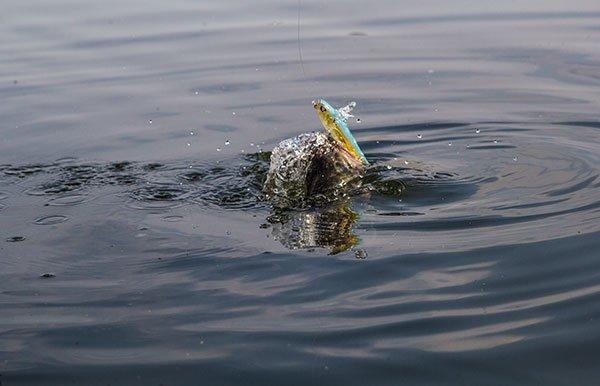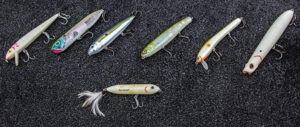Autumn just might be my favorite time of the year. With the nice break from the summer heat and the fish finally starting to cooperate again, there’s not a whole lot to dislike about it. I get giddy when the bass finally begin schooling as they chase shad into the shallows. After months of slow fishing, nothing beats catching sometimes hundreds of bass in a day. It’s a great way to release all of the frustration that has been built up from a summer full of jet skis, wakeboard boats and slow fishing.
Catching a bunch of bass is fun, I don’t care who you are. But what if you’re looking for bigger bites? One of the most common frustrations of fall fishing is the absence and irregularity of quality bites. While no one will ever have the “magic” answer to that question, the Wired2Fish crew all agree that big walking topwaters can definitely produce some huge bass.
Method to the madness
Many lakes are notorious for getting into an early fall funk. Much of the bait measures but a couple inches, and anglers find matching the hatch difficult at best when dealing with such diminutive forage. Many anglers get caught up in what I like to call “threadfin tunnel vision.” What are they doing? Where are they located? How big are they? While these are all outstanding questions to be asking yourself throughout your fishing day, to target the “sea cows,” a.k.a. big bass, we must also consider the additional forage that bass tend to target during the fall.
Gizzard shad are an often-overlooked favorite food source of big bass, and they get absolutely huge in the fall. So are meaty panfish like bluegills. For this reason, we’ve caught some really nice fall bass on big walking topwater baits. Huge topwater baits like a Strike King Sexy Dawg, Heddon Chug’n Spook, or the old Reaction Innovations Vixxen to emulate wounded gizzard shad well, driving big bass crazy.
Let’s think like a big bass for a minute: You’re hungry, fat and pretty lazy—life is tough for a big bass. You’re seeing thousands of small threadfin shad all around you, but there’s only one problem—those pesky 12-inchers are all over them, and you don’t feel like competing against them. To make matters more complicated, you’re going to have to eat a whole bunch of those small threadfins to get a full belly. All of the sudden, you look up and see what you believe to be a huge gizzard shad helplessly flopping around the surface of the water. Easy pickings, right? Why waste a bunch of energy on dinky threadfins when you can enjoy a full course meal of a tasty gizzard shad? It’s an easy decision for the bass to opt for the easier, larger meal.
Presentation triggers big bass
In bass fishing, presentation is everything. Even with the perfect lure, you need to present it correctly to maximize your success. While there are many different ways to fish big topwaters, we’ve found two specific techniques to be especially effective.
When an 8- or 10-inch gizzard shad is wounded and fighting for its life, it’s not going to be nonchalantly fluttering about in the water—it will be going absolutely haywire. For that reason, a slower, noisier approach when fishing big walking topwaters is a great way to entice some huge blowups. To start out, make long casts and work the lure to ensure a very wide walking action. To increase the amount of racket the lure creates, make very short, sharp downward twitches with your rod tip to obtain a loud “chugging” sound. If a bass strikes at the bait without being hooked, dramatically speed your cadence in order to imitate a gizzard shad in pure panic-mode.
Another equally effective retrieve for big topwater lures is to walk the bait very quickly across the surface. This particular retrieve is very effective in schooling situations. When shad, both gizzard and threadfin, are being pursued by hungry bass, they swim frantically in every direction in order to confuse and disorient the bass. Working a big topwater with a series of quick downward snaps of your rod tip gives bass the impression that a gizzard shad is getting away, triggering the bass’ predatory instinct to attack.
It is important to note that the same retrieve doesn’t always work—if you caught them last week using a slow, loud presentation, you may have to switch things up to a faster, wilder retrieve to get the most out of your fishing day. A bass’ preference can change daily, even hourly, so it’s always a great idea to try different presentations. Often clear water can change how the bass react to topwaters, as can overcast days.
So constantly change it up until you find a cadence to which the bass will react.Try upsizing your offering and experiment with different retrieves—it may prove to be the difference between a good day on the water and an awesome day on the water. You can catch average sized bass on big topwaters but you can also catch some really big bass in the fall on oversized walkers!
Left to right: Cotton Cordell Redfin, Heddon Chug’n Spook, Strike King Sexy Dawg, Ima Big Stick are much larger than the standard fall fair like a Super Spook.












